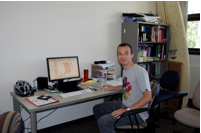
University:
Major:
Mentor(s):
Faculty Sponsor(s):
Faculty Sponsor's Department:
Project Title:
Project Description:
Magnesium hydride (MgH2) has great potential as a hydrogen storage material, since it is lightweight, non-toxic and inexpensive. A major obstacle in order to apply it as on-board source for pure hydrogen, e.g. to supply a fuel cell in a car, is the slow desorption kinetics. The dehydrogenation reaction occurs only above ~300°C[1], which is impractical for portable use. Ball-milled MgH2 contains the persistent ground-state a-phase and large portions of the metastable g-phase. This ball-milled material was found to have a ~60°C lower dehydrogenation onset temperature compared to commercial MgH2 powder[2], yet reasons are not fully understood. A possible explanation for the improved dehydrogenation may be a faster mass transport kinetics in the g-phase compared to the a-phase[3]. Mass transport requires the presence of mobile defects in the hydride crystal lattice. Identification and quantification of such defects based on experimental data is hardly possible. Therefore, our studies are based on density-functional theory (DFT) within the generalized gradient approximation (GGA) as implemented in the VASP code. The crystal phases and the defects in a- and g-MgH2 were simulated using periodic boundary conditions in supercells containing 96 atoms. The defect formation energies and migration barriers derived from our calculations allow us to determine the defect concentrations and their mobilities, respectively. We found that defects exist in higher concentration and are also more mobile in the g-phase than in the a-phase. These differences may explain the faster dehydrogenation kinetics of g-MgH2 and are consistent with experimental findings[2].
[1] L. Schlapbach, and A. Züttel, Nature 414, 353 (2001) [2] R. A. Varin, T. Czujko, and Z. Wronski, Nanotechnology 17, 3856 (2006) [3] M. S. Park, A. Janotti, and C. G. Van de Walle, Phys. Rev. B 80, 064102 (2009)
